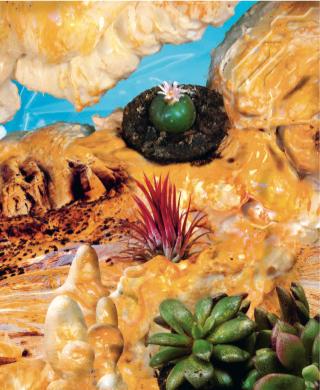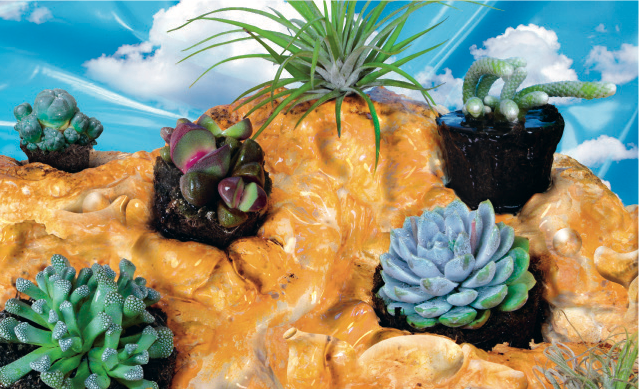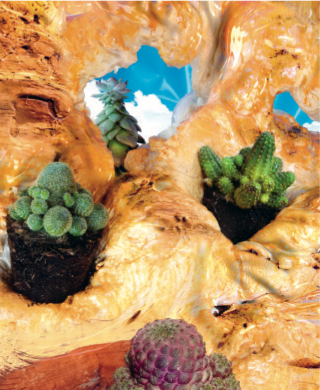CARLOS SÁEZ
Text by Michael Bullock
Artwork by Carlos Sáez
PIN-UP 26, 2019
BLOOM: A MACHINE ELF’S GUIDE TO DESERT FLORA
Since many deserts are hot (on average 100 degrees Fahrenheit daily) and dry (under 10 inches of precipitation annually), it’s often a reflex to think of them as barren. But set foot in any of these spectacular otherworldly environments and such notions will instantly be shattered. To illustrate this point, Spanish artist Carlos Sáez created this terrarium to showcase the many varieties of plant life that hot deserts support, from the Titanopsis of Namibia to the Sulcorebutia of Bolivia. It’s a project close to Sáez’s heart, because for a while now he has been proudly nurturing a Lophophora williamsii, more commonly known as a peyote cactus. “I’ll wait five years more and when it’s ready I will eat it,” he says of the psychoactive-rich plant. “It’s a poetic relationship: I grow a cactus that will eventually help me grow — my consciousness.”
The vastness and isolation of deserts have long made them attractive places for inner exploration through psychedelic experimentation, and this tabletop tundra is no different. With hallucinatory vision, Sáez pays homage to desert hydration by depicting rock formations that are just as juicy and alive as many of the succulents themselves. In fact, so animated are they that if you look closely you might be lucky enough to discover the first subtle signs of a “machine elf,” one of those amorphous humanoid figures that have been seen by shamanic users of hallucinogens in many cultures, from Native Americans to Africans to indigenous Australians, as well as by non-shamanic users of DMT (dimethyltryptamine). When encountered, the friendly multi- dimensional entities seem to say, “How wonderful you’re here! We’re delighted to see you! You come so rarely!” and then guide you on a hyper-stimulating metaphysical journey through the unexplored territories of your mind.
The term “machine elf” was coined by American author and ethnobotanist Terence McKenna (1946–2000), a prominent advocate for the responsible use of naturally occurring psychoactive plants. Sáez is a fan of Mckenna’s thinking. “These abstract, undefined beings link reality and virtuality,” he says. “Many people have seen them. If reality is the shared way we perceive the world, then why would an experience we all share on hallucinogens be considered any less real?”


